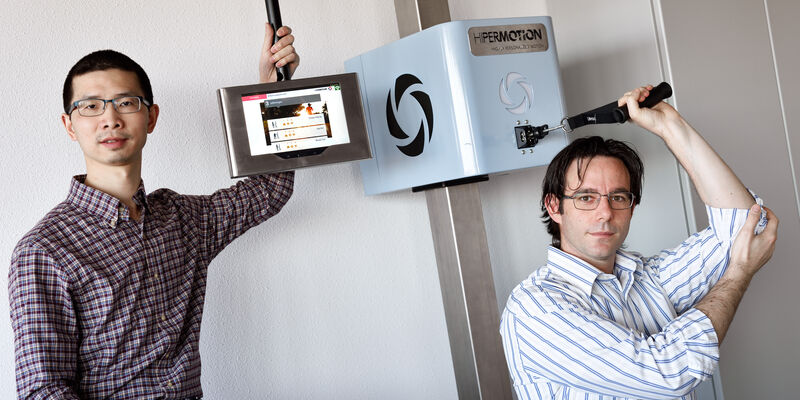
- Research
- 12/01/2016
Vibration makes workouts 25 to 100 percent more effective
By adding a 30 Hertz vibration to a workout session, the training impact of that workout can be boosted by 25 to 100 percent, researchers at TU/e have discovered. Their result is an important one, particularly for rehabilitating patients who need to regain their strength but have difficulty in generating the muscular effort needed for the exercises. Based on their work, the researchers built a new kind of fitness device that also enables sportsmen and women to become stronger more quickly.
What lies at the heart of the improved training effect is the vibration reflex of the muscles, a phenomenon whereby the muscles contract in response to vibration. Research leader Massimo Mischi has been investigating the possibility of using this phenomenon to boost the impact of workouts since 2005. He has been assisted by PhD student Lin Xu, who presents his thesis on this subject on Wednesday 13 January.
Mischi and Xu demonstrated among test subjects that workouts with a vibration of 30 Hertz boost the effect by at least 25 percent for the same weight without vibration. For a specific triceps exercise, the effect was even boosted by an average of 100 percent. The muscles were shown to work harder and were more quickly exhausted. In a different test, the test subjects appeared to be able to work with weights that were twice that of those used by test subjects without the vibration.
The results have particular significance for people who are weakened following an illness and need to rehabilitate, explains researcher Mischi. Exercises that use at least 70 percent muscular power are essential to quickly regain strength, and weakened patients are not often able to accomplish that. The new vibration method gives such patients a kind of short cut to quick rehabilitation.
But sportsmen and women can also benefit by achieving the same effect, or make progress, faster. “The well-known fitness slogan ‘no pain, no gain’ is thereby somewhat diluted by this”, Mischi says with a wink. He thought of the idea for the device more than ten years ago when he ran his own fitness club in Rome.
The knowledge that has been acquired has been incorporated in a new kind of fitness device, which spin-off company Hipermotion will be commercializing under the name of MaxDFM (Maximum Dynamic Force Modulation). Instead of a weight, a motor in this device produces the muscle load and the vibration, via a cable that has to be pulled out.
The motor is able to build up the load very precisely so that the joints are not subjected to the forces with a blow but gradually. That is also an advantage for rehabilitating patients and weaker sportsmen and women. Users are able to adjust the cable system to any height and length to enable all kinds of exercises to be done. Furthermore, the MaxDFM is operated entirely by a smartphone or tablet app, with individualized programs.
Source: TU/e press team
Discussion